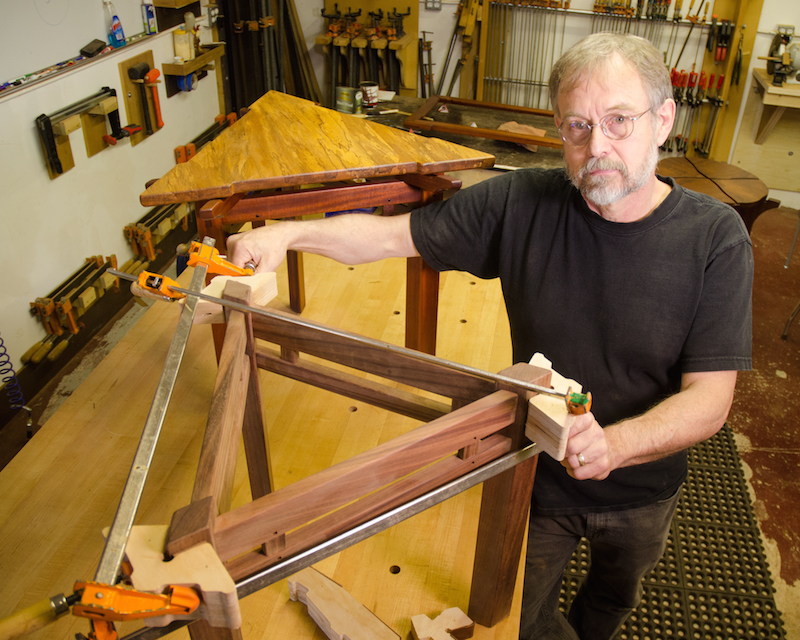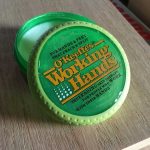We may receive a commission when you use our affiliate links. However, this does not impact our recommendations.
Meet the artists from the December 2017 issue
How five masterful makers integrate CNC and CAD technology into their woodworking
In the December 2017 issue of Popular Woodworking magazine, the article, Digital Artistry gives the readers a peek at what five professional woodworkers are doing with digital tools in their shops. Each has an extensive traditional woodworking background and many years of experience before they added digital tools like CAD software and CNC machines. All five are friends who meet regularly as a group, to exchange ideas and techniques as we explore this new digital world.
For the print article, I thought it would be more useful for readers if each woodworker would introduce themselves, say something about their backgrounds, their work and how they got started using digital tools. To do this, I sent out a survey to each member of the group with a series of questions.
With the space limitations inherent to print publishing, only a few quotes from each questionnaire made it into the final article. With so much information collected, I thought Popular Woodworking’s readers would like to hear more about each woodworker’s world. So, in this series of posts on Digital Artistry, I’ll share each woodworker’s survey answers with our online readers.
This post is about Seattle area furniture maker, Darrell Peart. Darrell is a long time woodworker with an extensive line of exceptional designed and produced Greene and Greene furniture. He’s a long time CAD user and has had a CNC in his shop for less than five years.
A video interview with Darrell in his shop…
Here’s Darrell in his own words…
Darrell Peart
History Section
A little bit about your woodworking history
My woodworking career started in 1970 making laminated beams. From there I ventured into self-employment, selling my work at Seattle’s Pike Place Market and various street fairs. From the mid 70’s until the mid-nineties I worked at various high-end custom shops all the while maintaining a home business making custom furniture. I have been full time self-employed ever since.
 Describe what you do as a woodworker?
Describe what you do as a woodworker?
My specialty, and what I am known for, is Greene & Greene style furniture. While I enjoy the challenge of figuring out how to do something new – my real love is design.
A quick description of your shop
Although I have a large maple bench with a pattern maker’s vice and do many of the finer details by hand – the bulk of my work is accomplished with machines. Besides the normal shop machines, I have 25 + routers – 2 Multi-routers – wide belt sander and of course a CNC router.
 How and when did you get started using digital woodworking tools? And, why?
How and when did you get started using digital woodworking tools? And, why?
Back in the late 80’s, I worked in a large shop where we decided to all purchase dial calipers in bulk. Dimensional control is a challenge with 150 people on the floor. The calipers changed things dramatically and I became a firm believer in precision woodworking.
A few years later I found myself operating a CNC machine for another large shop. This upped the game significantly – here I saw precision on a larger scale with the added bonus of non-linear precision.
I was hooked on CNC at this point – no going back. But to continue using CNC on my own, I needed to learn CAD so I could produce .dxf files which could, in turn, be used to have a CNC shop cut out my parts and templates.
Yet again – CAD was a game changer. No more full-scale layouts and the accuracy of my cut-lists improved dramatically.
 How do you use your new digital tools?
How do you use your new digital tools?
CAD/CAM has opened up many new possibilities.
- Designs that I deemed too time-consuming in the past have become routine and easy.
- Custom fixtures and various accessories for shop machines can be easily produced at moment’s notice
- Accurately produce furniture parts and/or templates
- Clamping cauls for oddly shaped glue- ups that precisely direct pressure for near stress-free operations (much less cursing and throwing of tools during glue-up)
 How did you/are you learning how to use these tools?
How did you/are you learning how to use these tools?
As stated before – much of my introduction and early use was on the job working for an employer. I am not much for diving into the minutiae for the sake of minutiae. I learn by the need to do something – then figure a way to do it.
Mistakes are a major source of learning – it forces me to sometimes dive into the details to find out what went wrong and why.
What are the challenges you have/had with these tools?
My biggest challenge has been getting past the technical details – of which there are many.
What benefits are you getting out of CAD?
The most profound benefit is how CAD relates to design and took me by surprise.
For me, design is usually a process of rendering. The revision for a design is usually just a fleeting image in my mind. If that image is not captured it is forever gone. In the old days (BC – before computers – CAD) the options were poor at best and many an idea and image escaped before I could capture it. With CAD, I can make a copy of a drawing and often have the revision in front of me in short order – while the inspiration is still fresh in my mind. This results in near-instant feedback – and in the process improves my design skills.
What benefits are you getting out of a using a CNC?
Many of the specific benefits have been discussed earlier. As a small business operator though, the CNC has allowed me to compete in the market. The precision and repeatability have had a profound effect on both quality and quantity of work – which has a huge impact on my bottom line.
It has allowed me to produce very complex projects which previously would have been far too time-consuming to produce profitably.
 Can you describe your CNC?
Can you describe your CNC?
- Twin spindle custom built by Carl Bruce
- over-travel in “X”
- 35” x 66” bed (accessible by both spindles)
- Vacuum hold-down
- Reference corners and a system to precisely locate pieces on the bed.
I often have a smaller diameter bit on the 2nd spindle to drill holes and get into tight corners (no need to stop and change bits). The over-travel allows me to clamp vertically and route joinery (mostly drawer parts). The reference corner allows me to quickly place parts on the bed for immediate registration.
What’s New
What’s different or surprised you once you started using these tools?
CAD/CAM has opened up a world of precision – one part does not need to be fitted to the next one. I can reliably produce perfect fitting parts without the need for prior fit. I still, out of habit, fit parts as I go along, though.
 What can you do that you couldn’t do before with these tools?
What can you do that you couldn’t do before with these tools?
It’s not so much that I couldn’t do these things before – but CAD/CNC has made very difficult things relatively easy.
Has your process changed with these tools? How so?
It has affected my entire approach. CNC/CAD has also become a source to modify existing shop machines with fixtures and accessories to accomplish a specific task.
Has your woodworking thinking changed by using these tools? If so, how?
Yes – only limited by my imagination. Specifics in answers above.
Describe how your work has changed since you have a CNC in your shop.
I love playing with geometric shapes and sometimes shapes that have a very little definition. CAD/CNC has allowed me to explore this with few if any restrictions. Instead of my processes or machines being the limiting factor – I am now only limited by my imagination.
What do you see in the future for your use of these tools in your shop?
Into uncharted territory. Design is my primary focus these days. These tools allow me to follow my whims – wherever they may go.
What’s the Potential?
Anything else you’d like to add?
In the beginning, I was attracted to woodworking because it was new and exciting – lots of stuff to explore. The world of CAD/CAM renews that excitement. The possibilities for adaptation are almost endless. For someone who enjoys coming up with creative solutions – CNC / CAD is the ultimate adult tinker-toy set.
 Anything else you think potential digital woodworkers should know?
Anything else you think potential digital woodworkers should know?
Don’t abandon traditional woodworking knowledge. Wood is still wood – its working properties don’t cease with the push of a button. The limitless possibilities of CAD/CNC are not achievable without some rudimentary knowledge of traditional woodworking.
With all the advantages of CAD/CAM – there is still a place for some procedures and operations to be done by hand. The right balance and mixture of hand/machine/ CNC is something that has to be explored on a personal basis.
More so than with traditional woodworking – precision becomes critical. Learn to use calipers and talk/measure in thousands-of-an-inch. Machining parts with great accuracy are essential. Flat and square are not relative terms – they are now absolutely absolute. The old rule of “cut one part and fit the next part to the 1st part” required a different kind of precision (not better or worse). Precision was still needed and in the end, the results are the same.
Parts and components of a project are now cut to fit precisely with little or no adjustment needed. Hence extreme precision is required at every stage.
 What would you do differently if you were starting out now?
What would you do differently if you were starting out now?
I am not sure if I would do much differently. Those things I learned before CAD/CNC have for the most part been beneficial.
Much of today’s technology was not available when I started out. But if it were – I probably would have made the technological jump much sooner.
Darrell Peart
Additional Resources
- Darrell Peart’s website click here
- All posts on the featured Digital Artists, click here
- December 2017 Issue of Popular Woodworking click here
- Digital Woodworking on Instagram
- Personal Work on Instagram
- Digital Woodworking YouTube Channel
Here are some supplies and tools we find essential in our everyday work around the shop. We may receive a commission from sales referred by our links; however, we have carefully selected these products for their usefulness and quality.












It seems that with woodworkers, the term, CNC, is either blasphemy, another tool, or somewhere in between. I have always fallen into the former, straying at times into the latter. I was thinking about the December Digital Artistry article while setting up a template to cut some pieces on my router when it landed on me, I’m basically replicating a simplified CNC. Why? Because it is more efficient and my time is valuable. I still feel the joy of creating something with my own hands, but I think it’s well past time that I move on past my prejudices and embrace change.
To all the artists, I love your work. Darrel, I’ve been following your work for a long time. When I need inspiration you are where I turn to first.